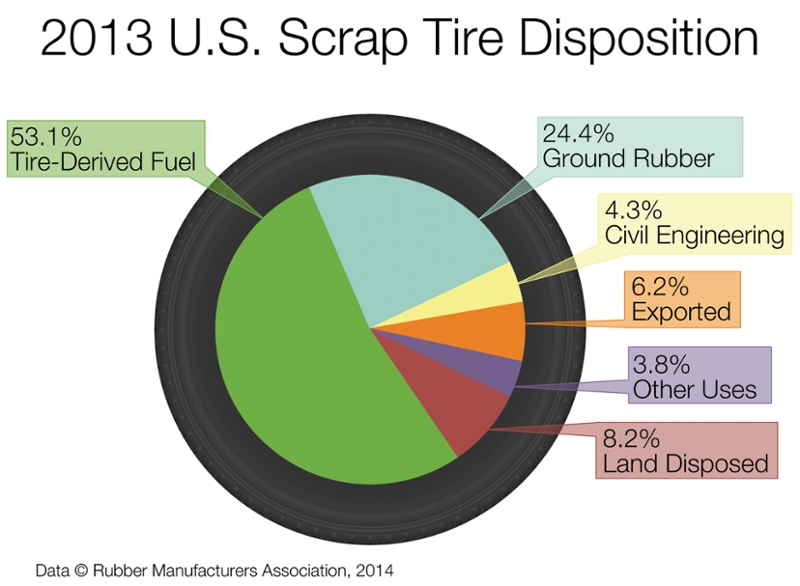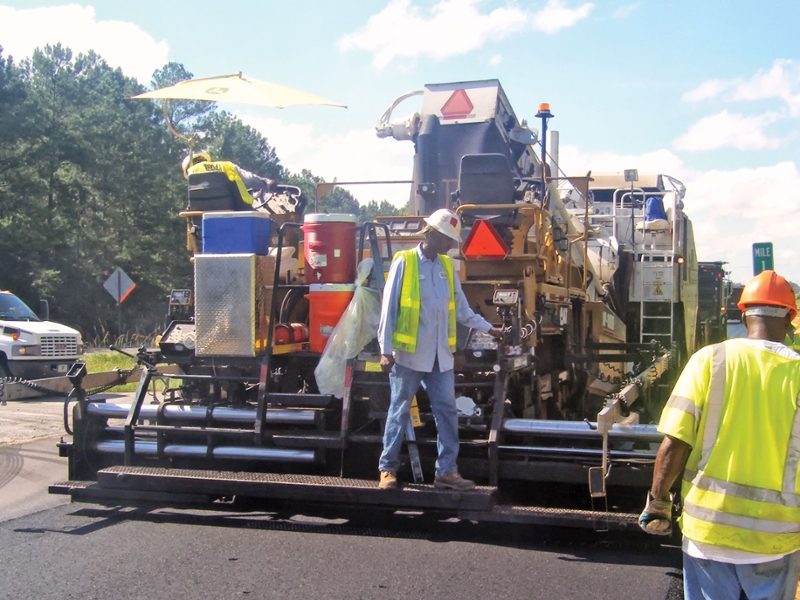Field Trials and Lab Tests Show Excellent Performance of GTR Modified Asphalt Mixes
Current reports estimate that approximately 233 million used tires are generated annually in the United States. Of these 233 million tires, approximately 91.8% are recycled or reused in fuel, agricultural or civil engineering markets, leaving 20 million tires that are disposed of in landfills or stockpiles. About 59.5 million scrap tires each year are being converted into ground tire rubber and used in rubber modified asphalt technologies.

The utilization of scrap tire rubber in asphalt pavements started in the mid-1960s when ground rubber was used in chip seal applications for roadway surfaces. Later on in the 1970s, ground tire rubber (GTR) modified asphalt chip seals were used as a stress-absorbing membrane interlayer. The use of GTR extended to asphalt mixtures and has continued to evolve due to its enhancement of mixture performance, including improved rutting and cracking.
In the early 1990s, a federal mandate required the use of rubber in asphalt mixtures; however, this mandate was later repealed and interest in the use of recycled tire rubber declined in most states. Some states, such as California, Arizona, Texas, and Florida, continued to use rubber modified asphalt technologies in many highway projects.
In 2008, a polymer shortage caused a significant increase in the price of polymer modified asphalt binders, and interest in rubber modified asphalt technologies was renewed. In August of 2010, the Alabama Department of Transportation (ALDOT) placed its first GTR modified asphalt mixture in over a decade outside of Dothan, Alabama on US-231 South. Blacklidge Emulsions terminally blended the GTR modified binder, which contained approximately 11% GTR and a crosslinking agent, before it was delivered to APAC Midsouth in Dothan. This binder met the requirements for a PG 76-22.

GTR modified mixture placed outside of Dothan, Alabama on US-231 South.
An experiment was developed by NCAT and ALDOT to compare the performance of the GTR modified asphalt mixture to that of a polymer modified asphalt mixture in both the laboratory and the field. The 19.0 mm maximum aggregate size surface mixtures contained similar aggregate structures and consisted of granite, limestone, screenings, shot gravel, sand, and 20% RAP. Due to the differences in the GTR and polymer modified binders, the asphalt contents and gradations differed slightly between the two mixtures. The GTR modified mixture had an asphalt content of 5.5%, while the polymer modified mixtures had 5.1% asphalt. The GTR modified mixture also had 0.5% more dust than the polymer modified mixture. Consequently, there were also volumetric differences between the two mixtures. The target thickness for each mixture was 1.5 inches and the target density was 93% of Gmm.
Mixtures and binders were sampled during construction so they could be tested at NCAT while trafficking occurred in the field. The binder was tested using the performance grade (PG) specification and the multiple stress creep recovery (MSCR) standard. The polymer modified binder had a true grade of PG 79.2 – 24.4, and the GTR modified binder had a true grade of PG 80.4 – 21.9. The m-value of the GTR binder did not meet the criterion for a low temperature grade of -22°C. Therefore, the binder was graded one performance grade higher than expected for the critical low temperature. Despite the properties of the GTR modified binder, results from the low temperature indirect tension creep compliance and strength tests indicated that both mixtures had critical low temperatures below -22°C.
It was also important to characterize the rutting and cracking resistance of both mixtures in the laboratory. The Asphalt Pavement Analyzer, Hamburg Wheel Tracking Test, and Flow Number were all used to assess the rutting susceptibility of these mixtures. In every case, the rubber modified mixture had equivalent or better performance than the polymer modified mixture.
The energy ratio (ER) method developed by the University of Florida and the semi-circular bend (SCB) test developed by the Louisiana Transportation Research Center (LTRC) were used to evaluate the potential for surface cracking in the mixtures. The energy ratio test uses two parameters to determine if the mixture is brittle (DSCEHMA < 0.75) or susceptible to surface cracking (ER < 1.95). Both mixtures easily exceeded the minimum DSCEHMA and minimum ER criteria. The rubber modified mixture had a slightly higher ER. For the SCB test, the J-integral is used to determine cracking susceptibility. The higher the J-integral, the less susceptible the mixture should be to cracking. The J-integral for the rubber mixture was 31% greater than that of the polymer modified mixture, suggesting greater resistance to surface cracking.
While laboratory test results are useful in assessing a mixture’s resistance to common distresses, the ultimate proof of a technology’s appropriateness is field performance. The field performance of each test section was evaluated to assess rutting, cracking, texture, and smoothness. The rut depths, texture, and smoothness of each test section were evaluated using an inertial profiler, while cracking was assessed by monitoring three 100-foot test strips in each test section.
After five years of trafficking, both test sections are free of cracking, and rutting in the sections is less than 4 mm. Additionally, both test sections were built smooth (IRI < 45 in/mile), and there has been no deterioration in pavement smoothness or change in texture.
A similar experiment also began in 2009 at the NCAT Test Track, where the Missouri Department of Transportation sponsored two test sections comparing a GTR modified mixture to a polymer modified mixture. After 10 million equivalent single axle loads (ESALs), there was no difference in the performance of these two test sections. The polymer modified test section was removed in the summer of 2012; however, the GTR test section remained in place for another 10 million ESALs. After a total of 20 million ESALs of traffic, there was minimal rutting and no cracking found in the test section. Laboratory experiments also showed equivalent performance between the two mixtures.
Given the comparable lab results and field performance for both the NCAT and Dothan test sections, which indicate equivalent performance of GTR and polymer modified mixtures, it appears that the asphalt pavement industry has several feasible options for providing the riding public with a smooth wearing surface that will perform well over time.